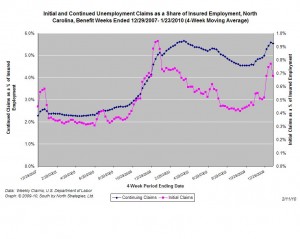12.02.2010
Policy Points
The latest version of the Job Openings and Labor Turnover Survey conducted by the U.S. Bureau of Labor Statistics found that job openings remained scarce in December, the most recent month for which data are available. As the Economic Policy Institute noted in its analysis of the data:
This morning, the Bureau of Labor Statistics released the December report from the Job Openings and Labor Turnover Survey (JOLTS), showing that job openings increased by 63,000 to 2.5 million in December. At the same time, the number of unemployed workers decreased by 73,000 to 15.3 million, resulting in 12.8 million more unemployed workers than job openings in December, or 6.1 job seekers per available job … This is a slight decline from 6.3 in November.
***
To absorb the over 15 million officially unemployed workers in this country, plus the nearly 2.5 million “marginally attached” workers (jobless workers who want a job but have given up actively seeking work and are therefore not counted as officially unemployed), job openings and hiring must rebound dramatically. This report offers no indication that that is happening — instead it adds to existing overwhelming evidence that it is time for substantial additional government action to revive the labor market.
11.02.2010
Policy Points
Economic policy reports, blog postings, and media stories of interest:
11.02.2010
Policy Points
For the benefit week ending on January 23rd, 19,385 North Carolinians filed initial claims for state unemployment insurance benefits, and 208,438 individuals applied for state-funded continuing benefits. Compared to the prior week, there were fewer initial claims but more continuing ones. These figures come from data released today by the U.S. Department of Labor.
Averaging new and continuing claims over a four-week period — a process that helps adjust for seasonal fluctuations and better illustrates trends — shows that an average of 26,323 initial claims were filed over the last four weeks, along with an average of 215,063 claims. Compared to the previous four-week period, both initial and continuing claims were lower.

One year ago, the four-week average for initial claims stood at 35,549 and the four-week average of continuing claims equaled 206,673.
The graph (right) shows the changes in unemployment insurance claims (as a share of covered employment) in North Carolina since the recession’s start in December 2007.
Although new and continuing claims appear to have peaked for this business cycle, the claims levels remain elevated and point to a labor market that remains extremely weak. Especially troubling is the high level of continuing claims, which suggests that unemployed individuals are finding it extremely difficult to find new positions.
11.02.2010
Policy Points
An article in The American Prospect explains how North Carolina balanced its budget for fiscal year 2010 and lays out the challenges facing the state next year.
“We’ve never had a shortfall of that size [25$ of the general fund] in our state,” says Meg Gray Wiehe, public-policy analyst for the North Carolina Justice Center. “But the cuts could have been much, much worse than what ultimately ended up happening.”
—
That’s because North Carolina’s Democrat- controlled Legislature decided against getting slash-happy. Instead it balanced the budget through three roughly equal measures: stimulus funds, cuts (Medicaid reimbursement rates and classroom size for fourth-grade through 12th-grade both suffered), and a temporary tax package.
…
Beyond the immediate crisis, the temporary tax increases have opened up the political space for a broader reform of North Carolina’s tax system, which relies on taxes that weigh heaviest on the poor. The budget includes language requiring the financial committees of both houses to meet during the off session to come up with recommendations for reforming the state’s outmoded tax system, which largely dates back to the 1930s.
—
“It’s a conversation we’ve been having for 50 years,” Wiehe says. “Now more than ever the political will to change it seems to be there.
10.02.2010
Policy Points
Economic policy reports, blog postings, and media stories of interest:


 Email Sign-Up
Email Sign-Up RSS Feed
RSS Feed